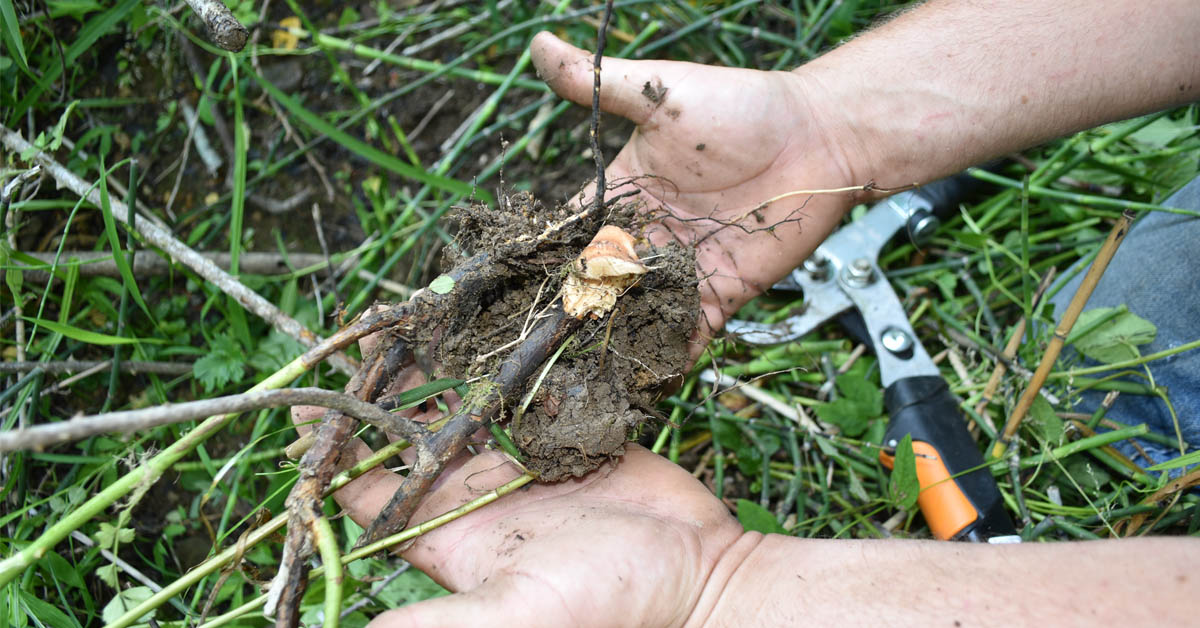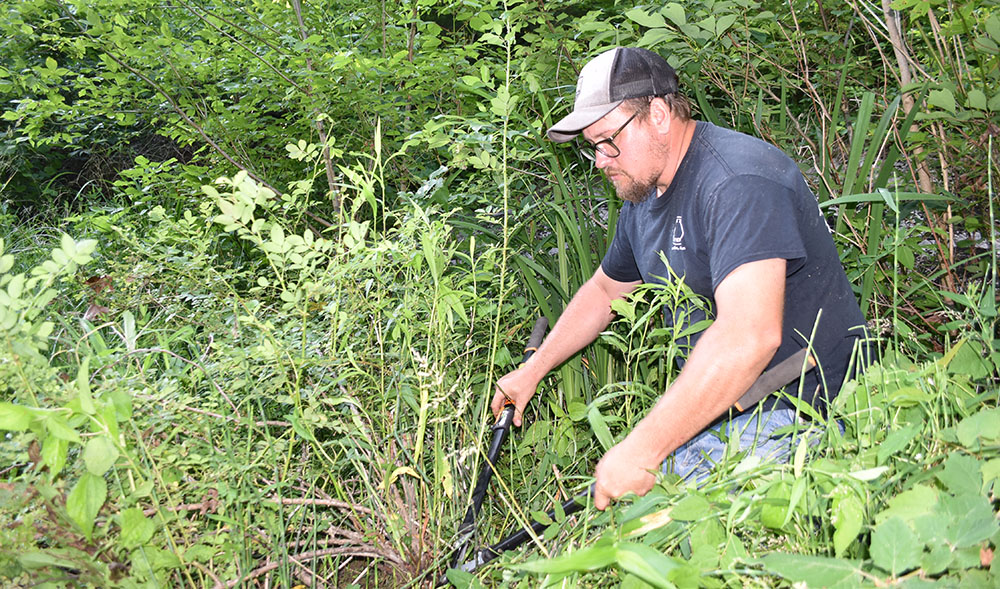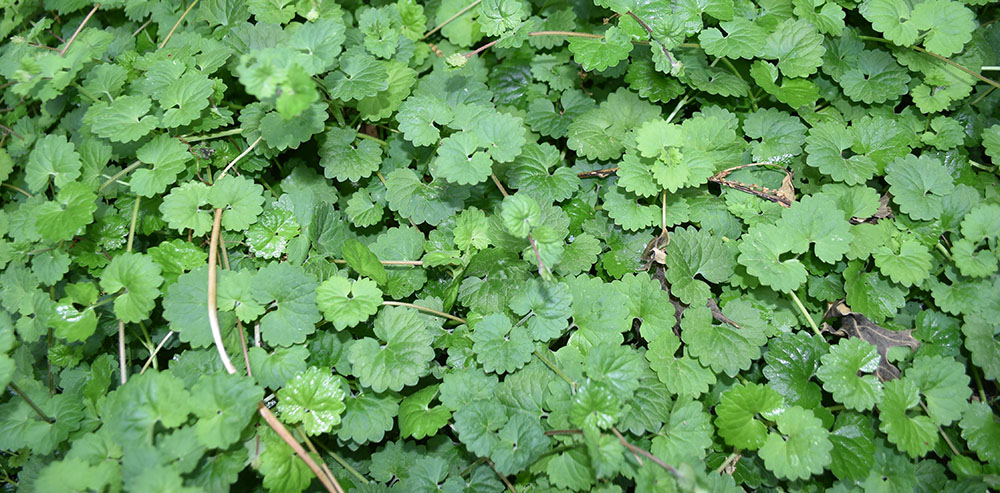
Be sure to kill the roots of invasive plants like these multiflora rose ones.
By Bruce Ingram
Photos by Bruce Ingram
Virginia Department of Wildlife Resources (DWR) Wildlife Biologist Dan Lovelace once joked with me that he started his career planting autumn olive (Elaeagnus umbellata) and will likely end it trying to kill the Asian invasive.
“Early in my career, we had a goal of planting 1,500 to 2,000 autumn olive seedlings each spring,” he said. “The plantings were successful and provided tons of fruit for turkey, grouse, songbirds, and bear. The problem now is that those tons of seed are sprouting everywhere, taking over fields and forest understory. This causes competition with beneficial native plants and degrades habitat quality for wildlife species.”
And Lovelace’s last statement remains a major issue involving invasive plants, regardless of whether you live on a suburban lot or the proverbial back 40 in rural Virginia—invasive plants often overwhelm and/or kill native flora. Unfortunately, the list of invasive plants is a long one.
“Similar competition is caused by sericea lespedeza (Lespedeza cuneate) and Johnson grass (Sorghum halepense) in open fields,” Lovelace continued. “A more recent invasive is Japanese stiltgrass (Microstegium vimineum), which rapidly blankets an area, particularly hardwood forest understory. Most everyone is familiar with kudzu (Pueraria montana) and maybe even Oriental bittersweet (Celastrus orbiculatus). These vines form dense canopies, damage growing trees, and suppress understory vegetation.
“Ailanthus (Ailanthus altissima) or tree-of-heaven, is a highly invasive tree species, commonly found along highway right-of-ways. Tree-of-Heaven forms dense stands and outcompetes other tree species, especially after a timber harvest. Another problem with invasive species is that they are extremely difficult to eradicate or control once they become established.”
Attacking Invasive Plants
With autumn olive and multiflora rose infesting my 38 acres in Botetourt County, I asked Eagle Rock, Virginia’s Trevor Saville, who operates T. Saville Forestry, to visit last summer. Our first stop was where multiflora rose had invaded the riparian zone of Catawba Creek, which flows through our land.
“Rose hips have likely floated downstream or found their way here through bird droppings,” he observed. “You have to be very careful if you spray here because most chemicals are highly miscible [mixable] in water, and you could damage the flora and fauna downstream.
“The first rule for eliminating invasive plants is to do no harm to native plants and animals. You have slippery elm, box elder, and horsetail growing nearby and we don’t want to hurt them or the fish in the creek.”
Fortunately, although widespread, the multiflora rose plants growing along the creek were small enough that we successfully pulled up all of them. Sometimes physically removing an invasive plant may be the best approach, especially if you can remove the entire plant. Later we came to another rose infestation that formed a true monoculture, some eight feet tall and 10 feet wide.

Trevor Saville cutting multiflora rose on the author’s land.
“This patch is too big—those thorns are vicious—to attack now,” Saville said. “My suggestion is that you come back when the plant is dormant when you can better see what you’re doing, and cut the entire patch to its base. Then spray with the appropriate herbicide.
“And when you spray, don’t do so until the liquid runs down the plant. Just dampen the cuts. Many people make two mistakes when spraying. They pour more chemicals into the water than the instructions say because they think more is better. Then they douse the plant with more spray than is needed, which is wasteful, expensive, and can cause damage to nearby plants. Just follow the directions on the bottle, which, frankly, most people don’t do.”
Stephen Living, Habitat Education Coordinator for DWR, offers more safety tips. “Herbicides can be an important tool in controlling invasive species,” he said. “It’s important that they be used carefully. Be sure to read the entire label and adhere to all instructions. When using any pesticide remember that ‘the label is the law.’ Importantly, be sure to follow any instructions for personal protective equipment or PPE-like eye protection and gloves. Different pesticides have different requirements.”

Trevor Saville applying a chemical to autumn olive stubs that have just been severed.
A third patch of invasive rose was far from the creek and of a manageable size, so Saville and I confronted it with the conventional cut and spray approach. Next, it was time to do battle with a patch of autumn olive that I’ve been trying to vanquish for several years. My first mistake was using an herbicide that is designed for killing weeds or grass, not woody growth. And the second time, I was only able to kill part of the growth even though I employed an herbicide designed for woody plants.
“Autumn olive can be extremely vigorous, even after it has been correctly cut and sprayed,” Saville explained. “Just missing a little bit of the cambium layer can cause a shrub to re-sprout.” At that, the forester cut all around the flora’s perimeter and sprayed the entire root collar. Our last stop was simply a target of opportunity.
“Wow, you’ve got a young persimmon growing along your forest edge,” Saville exclaimed. “I bet you’ve never seen it because of the autumn olive shading it? Let’s daylight that persimmon and let it get more sun.”
Saville assumed correctly, and I was reminded again of how invasive plants can often outcompete and conceal important native mast producers. The forester then carefully cut and sprayed the autumn olive and predicted that the persimmon would be producing its bounty much sooner than it would have otherwise.
Stop the Apocalypse
A few weeks later Joanne Yousten, a Soil Conservationist for the USDA-NRCS, came over to help me battle invasive flora. We decided to select a patch of forest about 20 yards long and 15 yards wide as our target area. The area borders my back yard, and can serve to simulate the size of woodlot many suburbanites possess—and also the invasive plants that might exist there. Yousten’s and my mission was to identify and kill those plants. It didn’t take long for us to encounter them.
“I see that you cut down all your dead ashes because of the emerald ash borer,” she said. “That was good to open up the canopy so that more sunlight could reach the forest floor and benefit native plants. But the invasive plants also took advantage. Ground ivy (Glechoma hederacea) has moved from your yard into the woods.

Ground ivy is one of the most aggressive of the invasive plants. In the past five years, it has almost totally covered the author’s backyard.
“A herbicide will kill it, but the problem, especially with ground ivy, is that unless you kill it all, it will come right back. And it’s just about impossible to kill it all.”
I told Yousten that I had given up trying to eliminate ground ivy as it had first appeared in my yard about five years ago and now blanketed almost the entire lot. Walking on, we soon encountered burning bush (Euonymus alatus), an invasive perennial from Asia.
“Burning bush is a really bad invasive shrub, and it’s really frustrating that stores still sell them and homeowners still plant them because of their bright red fall foliage,” Yousten said. “It seeds like crazy and hogs the habitat. Let’s cut it to its base and give it a shot of herbicide before those fruits ripen and birds spread the seeds.”
Before entering the woods, I told the soil conservationist that I had killed numerous autumn olive shrubs in this section of woods, but I was sure I had missed some. So it was no surprise to either of us that we soon located a patch of autumn olive.
“It’s an insidious plant,” she said. “The good news is that 100 species of songbirds will feed on it. The bad news is that a 100 species of songbirds will feed on and spread it. Look at the native raspberry, blackberry, and blueberry plants growing near it. Let’s cut and spray the olive so that wildlife don’t feed on those berries. We’ll stop the autumn olive apocalypse before it happens and crowds out all of the natives.”
Just as we were leaving the small section of woods, we encountered a few sprigs of multi-flora that she deftly cut and sprayed. I‘ve been hammering the thorny plant for several years and progress is being made. Start attacking the invasive plants in your back yard or back 40 and make your own progress toward helping our native flora and fauna.
Information Sources
Your local DWR, Department of Forestry, Soil and Water Conservation District, Virginia Cooperative Extension and NRCS office are just a few of the many sources that can help in your battle against invasive plants. Their websites also often offer helpful information.
On DWR’s website:
Native Alternatives to Invasive Plants
List of Virginia’s invasive plants: https://www.dcr.virginia.gov/natural-heritage/invsppdflist


